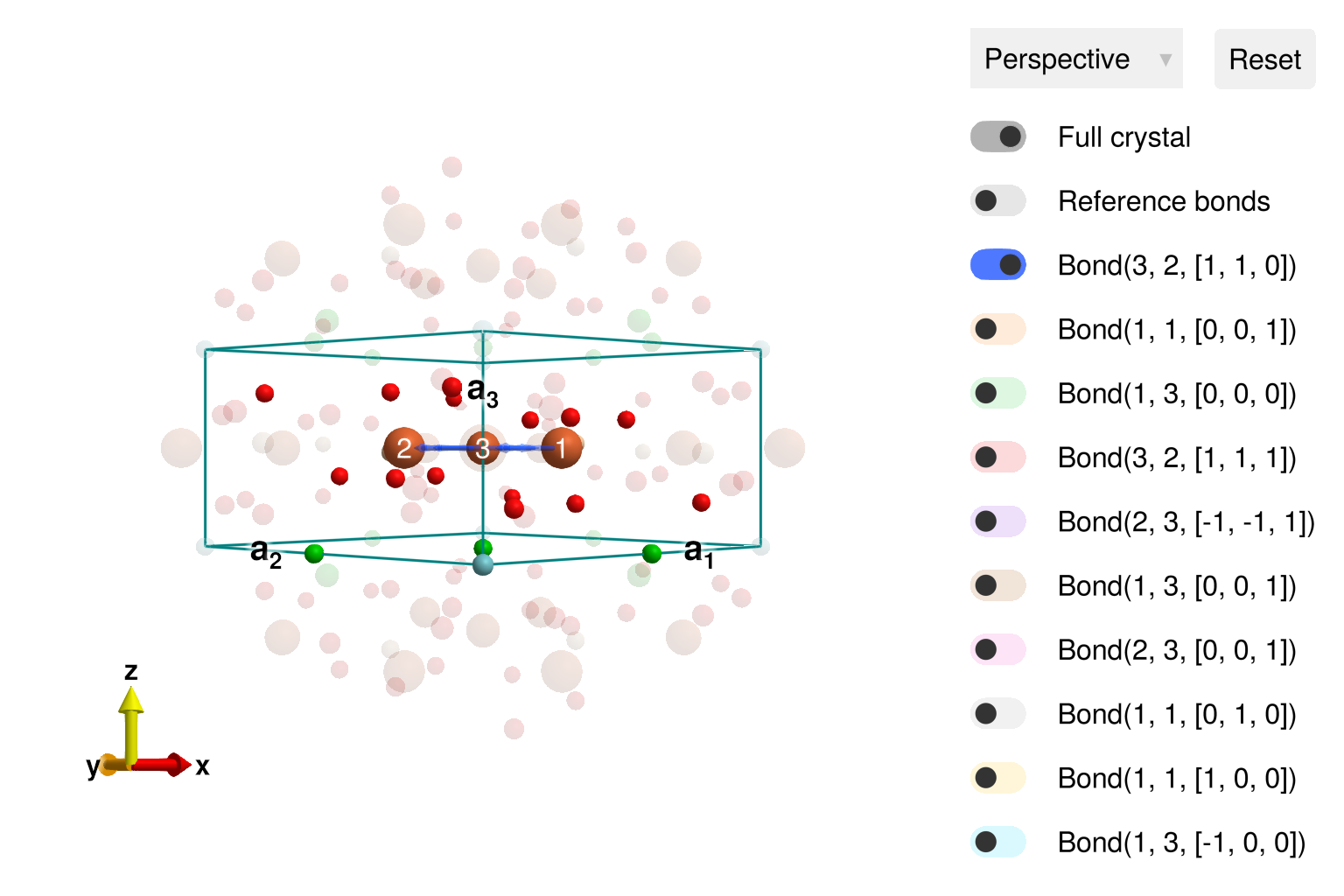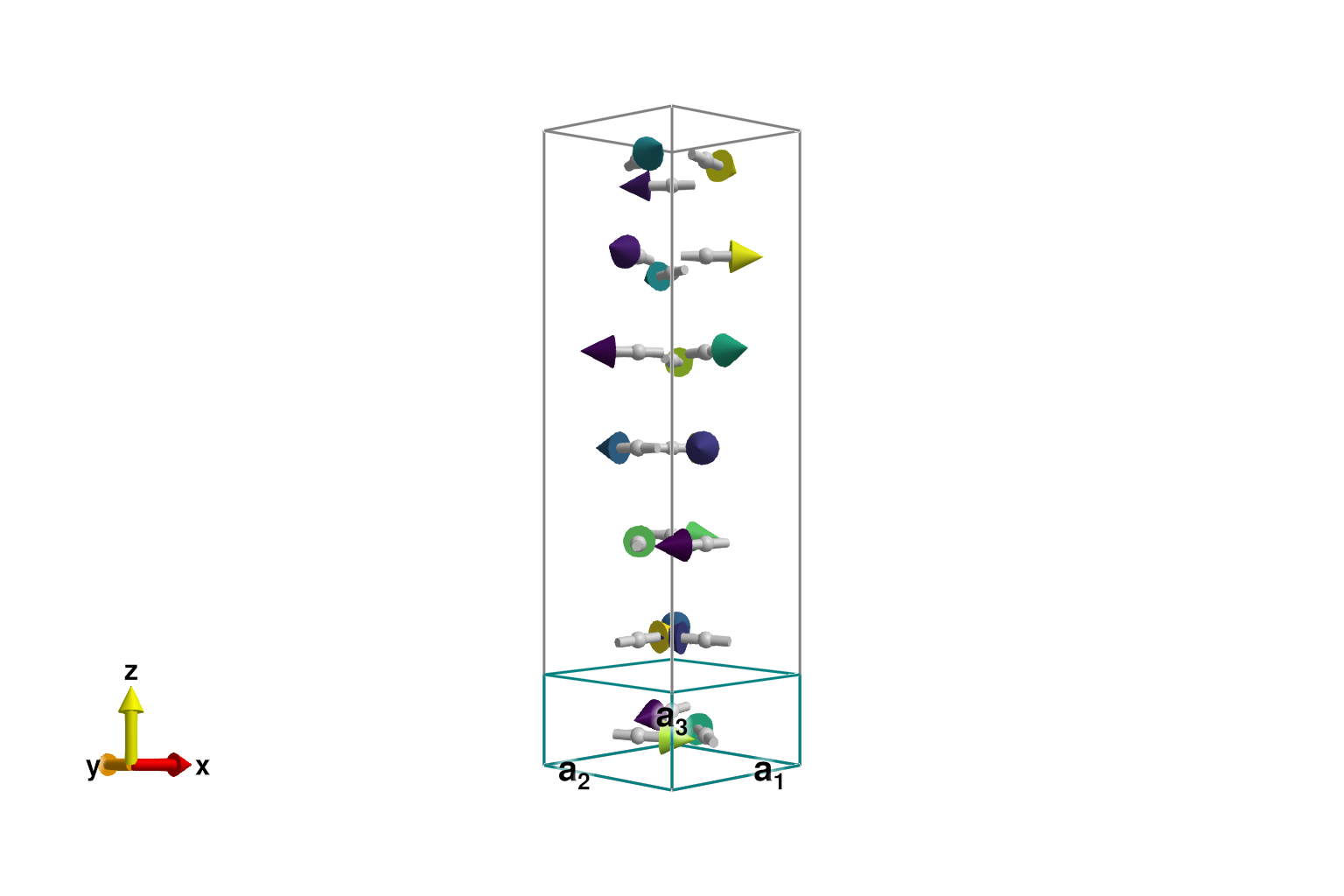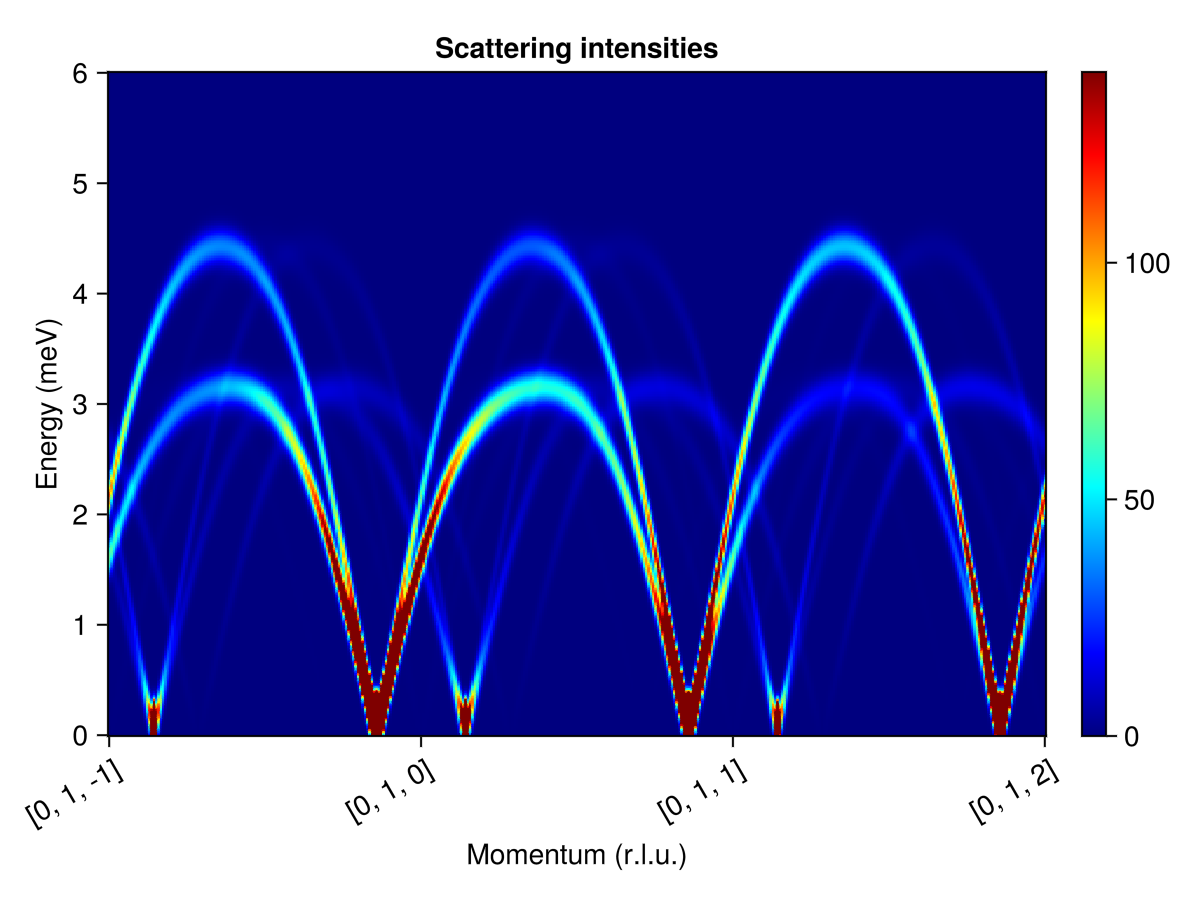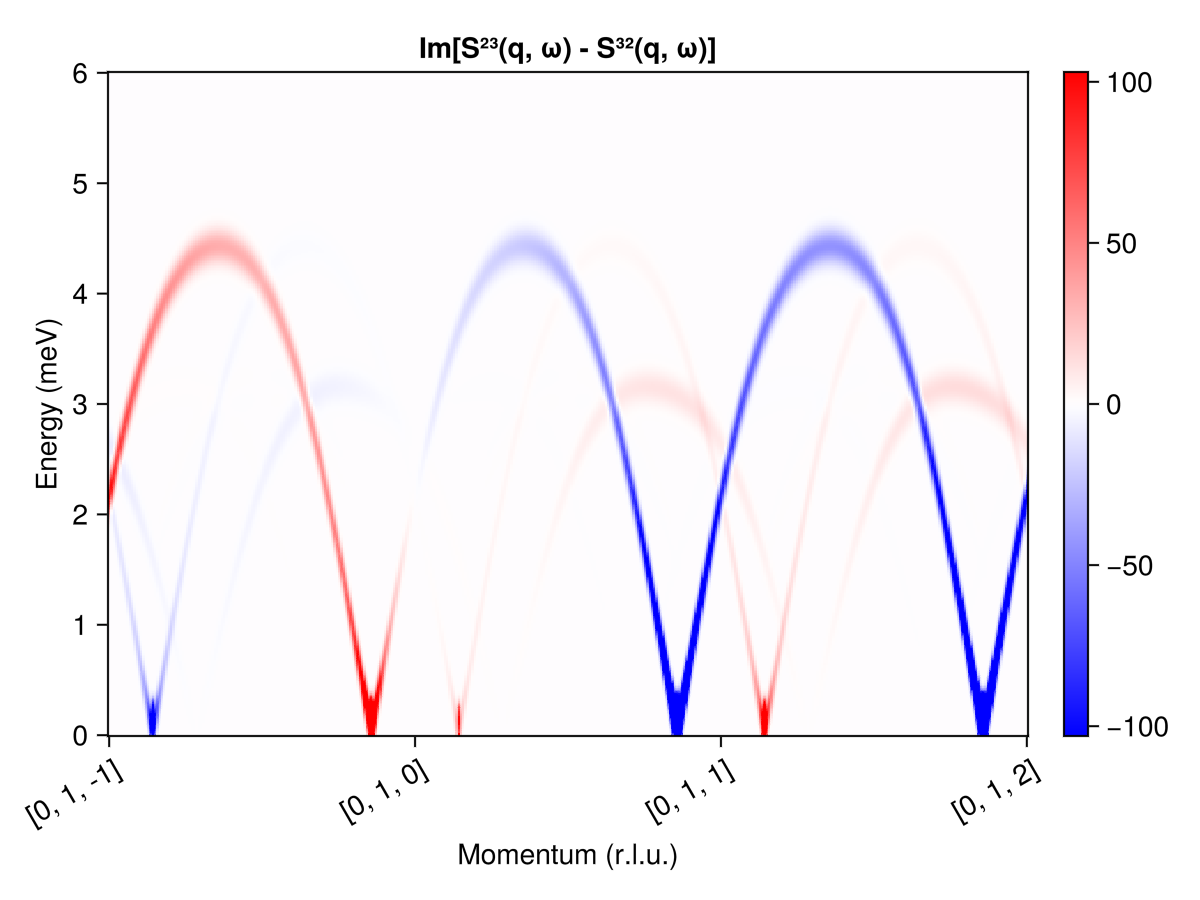Download this example as Julia file or Jupyter notebook.
SW15 - Ba₃NbFe₃Si₂O₁₄
This is a Sunny port of SpinW Tutorial 15, originally authored by Sandor Toth. It calculates the linear spin wave theory spectrum of Ba₃NbFe₃Si₂O₁₄. The ground state is an incommensurate spiral, which can be directly studied using the functions minimize_spiral_energy! and SpinWaveTheorySpiral.
Load packages
using Sunny, GLMakieSpecify the Ba₃NbFe₃Si₂O₁₄ Crystal cell following Marty et al., Phys. Rev. Lett. 101, 247201 (2008).
units = Units(:meV, :angstrom)
a = b = 8.539 # (Å)
c = 5.2414
latvecs = lattice_vectors(a, b, c, 90, 90, 120)
types = ["Fe", "Nb", "Ba", "Si", "O", "O", "O"]
positions = [[0.24964,0,0.5], [0,0,0], [0.56598,0,0], [2/3,1/3,0.5220],
[2/3,1/3,0.2162], [0.5259,0.7024,0.3536], [0.7840,0.9002,0.7760]]
langasite = Crystal(latvecs, positions, 150; types)
cryst = subcrystal(langasite, "Fe")
view_crystal(cryst)
Create a System and set exchange interactions as parametrized in Loire et al., Phys. Rev. Lett. 106, 207201 (2011).
sys = System(cryst, [1 => Moment(s=5/2, g=2)], :dipole)
J₁ = 0.85
J₂ = 0.24
J₃ = 0.053
J₄ = 0.017
J₅ = 0.24
set_exchange!(sys, J₁, Bond(3, 2, [1,1,0]))
set_exchange!(sys, J₄, Bond(1, 1, [0,0,1]))
set_exchange!(sys, J₂, Bond(1, 3, [0,0,0]))The final two exchanges are set according to the desired chirality $ϵ_T$ of the magnetic structure.
ϵT = -1
if ϵT == -1
set_exchange!(sys, J₃, Bond(2, 3, [-1,-1,1]))
set_exchange!(sys, J₅, Bond(3, 2, [1,1,1]))
elseif ϵT == 1
set_exchange!(sys, J₅, Bond(2, 3, [-1,-1,1]))
set_exchange!(sys, J₃, Bond(3, 2, [1,1,1]))
else
error("Chirality must be ±1")
endThis compound is known to have a spiral order with approximate propagation wavevector $𝐤 ≈ [0, 0, 1/7]$. Search for this magnetic order with minimize_spiral_energy!. Due to reflection symmetry, one of two possible propagation wavevectors may appear, $𝐤 = ± [0, 0, 0.1426…]$. Note that $k_z = 0.1426…$ is very close to $1/7 = 0.1428…$.
axis = [0, 0, 1]
randomize_spins!(sys)
k = minimize_spiral_energy!(sys, axis)3-element StaticArraysCore.SVector{3, Float64} with indices SOneTo(3):
-4.0494384689050114e-14
1.1549195027078438e-13
0.14264604656290372We can visualize the full magnetic cell using repeat_periodically_as_spiral, which includes 7 rotated copies of the chemical cell.
sys_enlarged = repeat_periodically_as_spiral(sys, (1, 1, 7); k, axis)
plot_spins(sys_enlarged; color=[S[1] for S in sys_enlarged.dipoles])
One could perform a spin wave calculation using either SpinWaveTheory on sys_enlarged, or SpinWaveTheorySpiral on the original sys. The latter has some restrictions on the interactions, but allows for our slightly incommensurate wavevector $𝐤$.
measure = ssf_perp(sys)
swt = SpinWaveTheorySpiral(sys; measure, k, axis)SpinWaveTheorySpiral(SpinWaveTheory(System([Dipole mode], Supercell (1×1×1)×3, Energy per site 9.601), Sunny.SWTDataDipole(StaticArraysCore.SMatrix{3, 3, Float64, 9}[[0.9184188029380164 -0.31978540708794206 0.23290383385316168; -0.21995199044135066 0.07658536233765013 0.9724997707848054; -0.3288282595988215 -0.9443897371791005 -2.371597192864302e-12], [0.5630345911680902 0.3953074374118729 0.7257575897467694; 0.5939767682063553 0.4170319866702959 -0.6879505221489116; -0.5746160874699868 0.8184230886410064 -2.9138301180912284e-12], [-0.0032619422115074937 -0.2845305513175667 -0.9586614236006008; 0.010989655345924278 0.9585984313440684 -0.2845492486373311; 0.9999342914453864 -0.011463541844186562 7.279793604807109e-12]], StaticArraysCore.SVector{3, Float64}[[1.8368376058760323, -0.639570814175884, 0.4658076677063235] [1.1260691823361804, 0.7906148748237458, 1.4515151794935388] [-0.0065238844230149804, -0.5690611026351329, -1.9173228472012]; [-0.4399039808827009, 0.15317072467530013, 1.94499954156961] [1.1879535364127103, 0.8340639733405916, -1.375901044297823] [0.021979310691848542, 1.9171968626881357, -0.569098497274662]; [-0.6576565191976429, -1.8887794743582005, -4.743194385728603e-12] [-1.1492321749399736, 1.6368461772820129, -5.827660236182457e-12] [1.9998685828907719, -0.022927083688373113, 1.455958720961421e-11]], Sunny.StevensExpansion[Sunny.StevensExpansion([0.0], [0.0, 0.0, 0.0, 0.0, 0.0], [0.0, 0.0, 0.0, 0.0, 0.0, 0.0, 0.0, 0.0, 0.0], [0.0, 0.0, 0.0, 0.0, 0.0, 0.0, 0.0, 0.0, 0.0, 0.0, 0.0, 0.0, 0.0], 0), Sunny.StevensExpansion([0.0], [0.0, 0.0, 0.0, 0.0, 0.0], [0.0, 0.0, 0.0, 0.0, 0.0, 0.0, 0.0, 0.0, 0.0], [0.0, 0.0, 0.0, 0.0, 0.0, 0.0, 0.0, 0.0, 0.0, 0.0, 0.0, 0.0, 0.0], 0), Sunny.StevensExpansion([0.0], [0.0, 0.0, 0.0, 0.0, 0.0], [0.0, 0.0, 0.0, 0.0, 0.0, 0.0, 0.0, 0.0, 0.0], [0.0, 0.0, 0.0, 0.0, 0.0, 0.0, 0.0, 0.0, 0.0, 0.0, 0.0, 0.0, 0.0], 0)], [1.5811388300841898, 1.5811388300841898, 1.5811388300841898]), MeasureSpec, 1.0e-8), [-4.0494384689050114e-14, 1.1549195027078438e-13, 0.14264604656290372], 3, [0.0, 0.0, 1.0], Matrix{StaticArraysCore.SMatrix{3, 3, ComplexF64, 9}}[[[0.0 + 0.0im 0.0 + 0.0im 0.0 + 0.0im; 0.0 + 0.0im 0.0 + 0.0im 0.0 + 0.0im; 0.0 + 0.0im 0.0 + 0.0im 0.0 + 0.0im] [0.0 + 0.0im 0.0 + 0.0im 0.0 + 0.0im; 0.0 + 0.0im 0.0 + 0.0im 0.0 + 0.0im; 0.0 + 0.0im 0.0 + 0.0im 0.0 + 0.0im] [0.0 + 0.0im 0.0 + 0.0im 0.0 + 0.0im; 0.0 + 0.0im 0.0 + 0.0im 0.0 + 0.0im; 0.0 + 0.0im 0.0 + 0.0im 0.0 + 0.0im]; [0.0 + 0.0im 0.0 + 0.0im 0.0 + 0.0im; 0.0 + 0.0im 0.0 + 0.0im 0.0 + 0.0im; 0.0 + 0.0im 0.0 + 0.0im 0.0 + 0.0im] [0.0 + 0.0im 0.0 + 0.0im 0.0 + 0.0im; 0.0 + 0.0im 0.0 + 0.0im 0.0 + 0.0im; 0.0 + 0.0im 0.0 + 0.0im 0.0 + 0.0im] [0.0 + 0.0im 0.0 + 0.0im 0.0 + 0.0im; 0.0 + 0.0im 0.0 + 0.0im 0.0 + 0.0im; 0.0 + 0.0im 0.0 + 0.0im 0.0 + 0.0im]; [0.0 + 0.0im 0.0 + 0.0im 0.0 + 0.0im; 0.0 + 0.0im 0.0 + 0.0im 0.0 + 0.0im; 0.0 + 0.0im 0.0 + 0.0im 0.0 + 0.0im] [0.0 + 0.0im 0.0 + 0.0im 0.0 + 0.0im; 0.0 + 0.0im 0.0 + 0.0im 0.0 + 0.0im; 0.0 + 0.0im 0.0 + 0.0im 0.0 + 0.0im] [0.0 + 0.0im 0.0 + 0.0im 0.0 + 0.0im; 0.0 + 0.0im 0.0 + 0.0im 0.0 + 0.0im; 0.0 + 0.0im 0.0 + 0.0im 0.0 + 0.0im]], [[0.0 + 0.0im 0.0 + 0.0im 0.0 + 0.0im; 0.0 + 0.0im 0.0 + 0.0im 0.0 + 0.0im; 0.0 + 0.0im 0.0 + 0.0im 0.0 + 0.0im] [0.0 + 0.0im 0.0 + 0.0im 0.0 + 0.0im; 0.0 + 0.0im 0.0 + 0.0im 0.0 + 0.0im; 0.0 + 0.0im 0.0 + 0.0im 0.0 + 0.0im] [0.0 + 0.0im 0.0 + 0.0im 0.0 + 0.0im; 0.0 + 0.0im 0.0 + 0.0im 0.0 + 0.0im; 0.0 + 0.0im 0.0 + 0.0im 0.0 + 0.0im]; [0.0 + 0.0im 0.0 + 0.0im 0.0 + 0.0im; 0.0 + 0.0im 0.0 + 0.0im 0.0 + 0.0im; 0.0 + 0.0im 0.0 + 0.0im 0.0 + 0.0im] [0.0 + 0.0im 0.0 + 0.0im 0.0 + 0.0im; 0.0 + 0.0im 0.0 + 0.0im 0.0 + 0.0im; 0.0 + 0.0im 0.0 + 0.0im 0.0 + 0.0im] [0.0 + 0.0im 0.0 + 0.0im 0.0 + 0.0im; 0.0 + 0.0im 0.0 + 0.0im 0.0 + 0.0im; 0.0 + 0.0im 0.0 + 0.0im 0.0 + 0.0im]; [0.0 + 0.0im 0.0 + 0.0im 0.0 + 0.0im; 0.0 + 0.0im 0.0 + 0.0im 0.0 + 0.0im; 0.0 + 0.0im 0.0 + 0.0im 0.0 + 0.0im] [0.0 + 0.0im 0.0 + 0.0im 0.0 + 0.0im; 0.0 + 0.0im 0.0 + 0.0im 0.0 + 0.0im; 0.0 + 0.0im 0.0 + 0.0im 0.0 + 0.0im] [0.0 + 0.0im 0.0 + 0.0im 0.0 + 0.0im; 0.0 + 0.0im 0.0 + 0.0im 0.0 + 0.0im; 0.0 + 0.0im 0.0 + 0.0im 0.0 + 0.0im]], [[0.0 + 0.0im 0.0 + 0.0im 0.0 + 0.0im; 0.0 + 0.0im 0.0 + 0.0im 0.0 + 0.0im; 0.0 + 0.0im 0.0 + 0.0im 0.0 + 0.0im] [0.0 + 0.0im 0.0 + 0.0im 0.0 + 0.0im; 0.0 + 0.0im 0.0 + 0.0im 0.0 + 0.0im; 0.0 + 0.0im 0.0 + 0.0im 0.0 + 0.0im] [0.0 + 0.0im 0.0 + 0.0im 0.0 + 0.0im; 0.0 + 0.0im 0.0 + 0.0im 0.0 + 0.0im; 0.0 + 0.0im 0.0 + 0.0im 0.0 + 0.0im]; [0.0 + 0.0im 0.0 + 0.0im 0.0 + 0.0im; 0.0 + 0.0im 0.0 + 0.0im 0.0 + 0.0im; 0.0 + 0.0im 0.0 + 0.0im 0.0 + 0.0im] [0.0 + 0.0im 0.0 + 0.0im 0.0 + 0.0im; 0.0 + 0.0im 0.0 + 0.0im 0.0 + 0.0im; 0.0 + 0.0im 0.0 + 0.0im 0.0 + 0.0im] [0.0 + 0.0im 0.0 + 0.0im 0.0 + 0.0im; 0.0 + 0.0im 0.0 + 0.0im 0.0 + 0.0im; 0.0 + 0.0im 0.0 + 0.0im 0.0 + 0.0im]; [0.0 + 0.0im 0.0 + 0.0im 0.0 + 0.0im; 0.0 + 0.0im 0.0 + 0.0im 0.0 + 0.0im; 0.0 + 0.0im 0.0 + 0.0im 0.0 + 0.0im] [0.0 + 0.0im 0.0 + 0.0im 0.0 + 0.0im; 0.0 + 0.0im 0.0 + 0.0im 0.0 + 0.0im; 0.0 + 0.0im 0.0 + 0.0im 0.0 + 0.0im] [0.0 + 0.0im 0.0 + 0.0im 0.0 + 0.0im; 0.0 + 0.0im 0.0 + 0.0im 0.0 + 0.0im; 0.0 + 0.0im 0.0 + 0.0im 0.0 + 0.0im]], [[0.0 + 0.0im 0.0 + 0.0im 0.0 + 0.0im; 0.0 + 0.0im 0.0 + 0.0im 0.0 + 0.0im; 0.0 + 0.0im 0.0 + 0.0im 0.0 + 0.0im] [0.0 + 0.0im 0.0 + 0.0im 0.0 + 0.0im; 0.0 + 0.0im 0.0 + 0.0im 0.0 + 0.0im; 0.0 + 0.0im 0.0 + 0.0im 0.0 + 0.0im] [0.0 + 0.0im 0.0 + 0.0im 0.0 + 0.0im; 0.0 + 0.0im 0.0 + 0.0im 0.0 + 0.0im; 0.0 + 0.0im 0.0 + 0.0im 0.0 + 0.0im]; [0.0 + 0.0im 0.0 + 0.0im 0.0 + 0.0im; 0.0 + 0.0im 0.0 + 0.0im 0.0 + 0.0im; 0.0 + 0.0im 0.0 + 0.0im 0.0 + 0.0im] [0.0 + 0.0im 0.0 + 0.0im 0.0 + 0.0im; 0.0 + 0.0im 0.0 + 0.0im 0.0 + 0.0im; 0.0 + 0.0im 0.0 + 0.0im 0.0 + 0.0im] [0.0 + 0.0im 0.0 + 0.0im 0.0 + 0.0im; 0.0 + 0.0im 0.0 + 0.0im 0.0 + 0.0im; 0.0 + 0.0im 0.0 + 0.0im 0.0 + 0.0im]; [0.0 + 0.0im 0.0 + 0.0im 0.0 + 0.0im; 0.0 + 0.0im 0.0 + 0.0im 0.0 + 0.0im; 0.0 + 0.0im 0.0 + 0.0im 0.0 + 0.0im] [0.0 + 0.0im 0.0 + 0.0im 0.0 + 0.0im; 0.0 + 0.0im 0.0 + 0.0im 0.0 + 0.0im; 0.0 + 0.0im 0.0 + 0.0im 0.0 + 0.0im] [0.0 + 0.0im 0.0 + 0.0im 0.0 + 0.0im; 0.0 + 0.0im 0.0 + 0.0im 0.0 + 0.0im; 0.0 + 0.0im 0.0 + 0.0im 0.0 + 0.0im]], [[0.0 + 0.0im 0.0 + 0.0im 0.0 + 0.0im; 0.0 + 0.0im 0.0 + 0.0im 0.0 + 0.0im; 0.0 + 0.0im 0.0 + 0.0im 0.0 + 0.0im] [0.0 + 0.0im 0.0 + 0.0im 0.0 + 0.0im; 0.0 + 0.0im 0.0 + 0.0im 0.0 + 0.0im; 0.0 + 0.0im 0.0 + 0.0im 0.0 + 0.0im] [0.0 + 0.0im 0.0 + 0.0im 0.0 + 0.0im; 0.0 + 0.0im 0.0 + 0.0im 0.0 + 0.0im; 0.0 + 0.0im 0.0 + 0.0im 0.0 + 0.0im]; [0.0 + 0.0im 0.0 + 0.0im 0.0 + 0.0im; 0.0 + 0.0im 0.0 + 0.0im 0.0 + 0.0im; 0.0 + 0.0im 0.0 + 0.0im 0.0 + 0.0im] [0.0 + 0.0im 0.0 + 0.0im 0.0 + 0.0im; 0.0 + 0.0im 0.0 + 0.0im 0.0 + 0.0im; 0.0 + 0.0im 0.0 + 0.0im 0.0 + 0.0im] [0.0 + 0.0im 0.0 + 0.0im 0.0 + 0.0im; 0.0 + 0.0im 0.0 + 0.0im 0.0 + 0.0im; 0.0 + 0.0im 0.0 + 0.0im 0.0 + 0.0im]; [0.0 + 0.0im 0.0 + 0.0im 0.0 + 0.0im; 0.0 + 0.0im 0.0 + 0.0im 0.0 + 0.0im; 0.0 + 0.0im 0.0 + 0.0im 0.0 + 0.0im] [0.0 + 0.0im 0.0 + 0.0im 0.0 + 0.0im; 0.0 + 0.0im 0.0 + 0.0im 0.0 + 0.0im; 0.0 + 0.0im 0.0 + 0.0im 0.0 + 0.0im] [0.0 + 0.0im 0.0 + 0.0im 0.0 + 0.0im; 0.0 + 0.0im 0.0 + 0.0im 0.0 + 0.0im; 0.0 + 0.0im 0.0 + 0.0im 0.0 + 0.0im]], [[0.0 + 0.0im 0.0 + 0.0im 0.0 + 0.0im; 0.0 + 0.0im 0.0 + 0.0im 0.0 + 0.0im; 0.0 + 0.0im 0.0 + 0.0im 0.0 + 0.0im] [0.0 + 0.0im 0.0 + 0.0im 0.0 + 0.0im; 0.0 + 0.0im 0.0 + 0.0im 0.0 + 0.0im; 0.0 + 0.0im 0.0 + 0.0im 0.0 + 0.0im] [0.0 + 0.0im 0.0 + 0.0im 0.0 + 0.0im; 0.0 + 0.0im 0.0 + 0.0im 0.0 + 0.0im; 0.0 + 0.0im 0.0 + 0.0im 0.0 + 0.0im]; [0.0 + 0.0im 0.0 + 0.0im 0.0 + 0.0im; 0.0 + 0.0im 0.0 + 0.0im 0.0 + 0.0im; 0.0 + 0.0im 0.0 + 0.0im 0.0 + 0.0im] [0.0 + 0.0im 0.0 + 0.0im 0.0 + 0.0im; 0.0 + 0.0im 0.0 + 0.0im 0.0 + 0.0im; 0.0 + 0.0im 0.0 + 0.0im 0.0 + 0.0im] [0.0 + 0.0im 0.0 + 0.0im 0.0 + 0.0im; 0.0 + 0.0im 0.0 + 0.0im 0.0 + 0.0im; 0.0 + 0.0im 0.0 + 0.0im 0.0 + 0.0im]; [0.0 + 0.0im 0.0 + 0.0im 0.0 + 0.0im; 0.0 + 0.0im 0.0 + 0.0im 0.0 + 0.0im; 0.0 + 0.0im 0.0 + 0.0im 0.0 + 0.0im] [0.0 + 0.0im 0.0 + 0.0im 0.0 + 0.0im; 0.0 + 0.0im 0.0 + 0.0im 0.0 + 0.0im; 0.0 + 0.0im 0.0 + 0.0im 0.0 + 0.0im] [0.0 + 0.0im 0.0 + 0.0im 0.0 + 0.0im; 0.0 + 0.0im 0.0 + 0.0im 0.0 + 0.0im; 0.0 + 0.0im 0.0 + 0.0im 0.0 + 0.0im]]])Calculate broadened intensities for a path $[0, 1, L]$ through reciprocal space
qs = [[0, 1, -1], [0, 1, -1+1], [0, 1, -1+2], [0, 1, -1+3]]
path = q_space_path(cryst, qs, 400)
energies = range(0, 6, 400)
res = intensities(swt, path; energies, kernel=gaussian(fwhm=0.25))
plot_intensities(res; units, saturation=0.7, colormap=:jet, title="Scattering intensities")
Use ssf_custom_bm to calculate the imaginary part of $\mathcal{S}^{2, 3}(𝐪, ω) - \mathcal{S}^{3, 2}(𝐪, ω)$. In polarized neutron scattering, it is conventional to express the 3×3 structure factor matrix $\mathcal{S}^{α, β}(𝐪, ω)$ in the Blume-Maleev polarization axis system. Specify the scattering plane $[0, K, L]$ via the spanning vectors $𝐮 = [0, 1, 0]$ and $𝐯 = [0, 0, 1]$.
measure = ssf_custom_bm(sys; u=[0, 1, 0], v=[0, 0, 1]) do q, ssf
imag(ssf[2,3] - ssf[3,2])
end
swt = SpinWaveTheorySpiral(sys; measure, k, axis)
res = intensities(swt, path; energies, kernel=gaussian(fwhm=0.25))
plot_intensities(res; units, saturation=0.8, allpositive=false,
title="Im[S²³(q, ω) - S³²(q, ω)]")